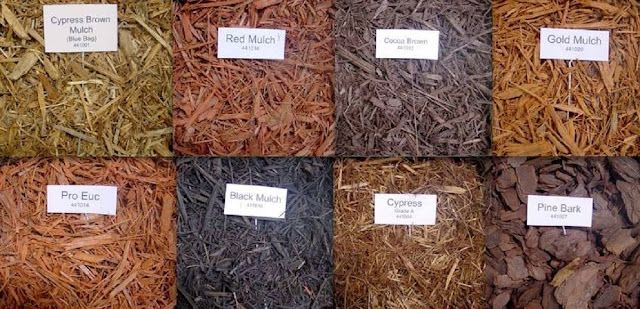There is a lot of conjecture out there about what is a mulch and
how thick should it be? And a whole range of other questions that I will
endeavour to answer or set straight in this article. This is of course in my
opinion and based on my own experience of over 40 years of growing my own food
and fruit on urban blocks of land.
- Pebbles/Stones: Not mulch
heats up during day and radiates warmth into soil sending composting insects
deep.
- Lucerne: Not mulch
too open and is full of nitrogen and really is meant as a green manure so good
in the compost or turned into the ground.
- Pea Straw: Not mulch
to open just like Lucerne makes a great green manure.
Let’s look at what are mulches?
- Bark/Wood
Chips: Great for native gardens, but not so good for edibles. It can
leech Nitrogen out of the soil and deposit sap’s and resins which aren’t good
for edibles.
- Sugarcane: This is
an adequate mulch for edibles it takes about 12 months to break down.
- Bamboo Mulch: Like sugar
cane also good for edibles with a similar break down time.
- Whoflungdung: This is
an activated mulch and best I have used to date albeit a little more expensive
but gives you great results being bio-active.
Ok so how thick should it be applied? 25mm and no more I find any
thicker and you miss out on good water penetration, thicker layer of mulch you
will find after watering for a decent time, when you check all you have managed
to do is water the mulch layer and not the soil. Not so long ago the thinking
was to put mulch on a minimum of 100mm thick, this is no longer the
recommendation.
In my opinion soil in any garden bed with or without plants should
never be without mulch! Applying mulch has quite a few benefits for you and
your garden that I think a lot of people miss. Just by its presence it will
increase the microbial activity in the soil as it slowly starts to break down,
and ultimately adding nourishment over time. The cover of mulch will also
inhibit weed growth as it blocks out one of the three things weeds need to
germinate, water, food, and light, it won’t stop all of them but it certainly
helps keep them down. It is a great insulator for the soil as in the cooler
months it keeps the soil a little warmer assisting those plants that are not
dormant to grow a little better, and in the summer it keeps the soil cooler
stopping evaporation and leaving the soil moister than it would be if it
weren’t there.
One of the biggest impacts mulching has on your garden is that it
allows the composting insects cover from the sun, cooling the soil and keeping
it moist and they return to the surface under the cover of the much eating away
at it turning it into rich friable soil. This causes aeration in the soil as
these insects and invertebrates move about in the soil turning the soil over
for you saving you the hard work, “I don’t know about you but I am a big
advocate of not having a dog and barking too.”
I don’t turn my soil over hardly ever, I let them do the hard work.
A garden bed without mulch doesn’t have this activity going on in it, as the
composting insects are down deeper in the soil up to 200mm deep where the soil
is moist and cool even in the winter months. So you can see mulch is vitally
important. All of this ensures that when you water you will get fantastic water
penetration where it is needed. Without mulch the soil becomes hard and dry and
dehydrated the composting insects travel down into the soil deep where it is
cool and your soil becomes hard to work. Take the hard work out of gardening
and mulch it, you will be surprised in the change.
I even use mulch in the top of my potted plants, you will be surprised at what a difference it will make to the amount you water them and to the health of the plant or tree.


Comments
Post a Comment